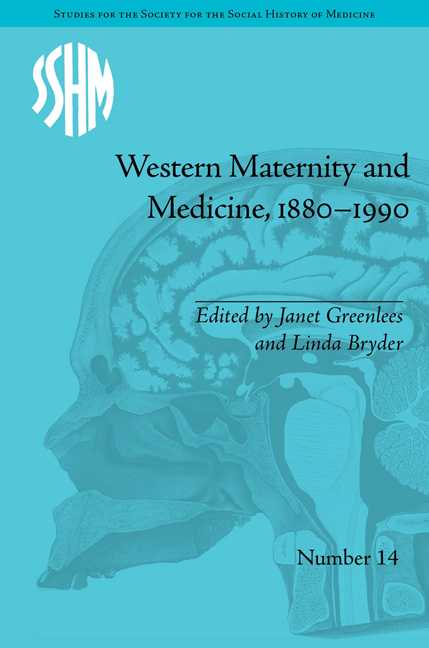Book contents
- Frontmatter
- CONTENTS
- Acknowledgements
- List of Contributors
- List of Tables
- Western Maternity and Medicine: An Introduction
- 1 Safely Delivered? Insights into Late Nineteenth-Century Australian Maternity Care from Coronial Investigations into Maternal Deaths
- 2 Pregnancy, Pathology and Public Morals: Making Antenatal Care in Edinburgh around 1900
- 3 ‘The Peculiar and Complex Female Problem’: The Church of Scotland and Health Care for Unwed Mothers, 1900–1948
- 4 Taking ‘Advantage of the Facilities and Comforts … Offered’: Women's Choice of Hospital Delivery in Interwar Edinburgh
- 5 ‘What Women Want’: Childbirth Services and Women's Activism in New Zealand, 1900–1960
- 6 'Twixt God and Geography: The Development of Maternity Services in Twentieth-Century Ireland
- 7 Test Tubes and Turpitude: Medical Responses to the Infertile Patient in Mid-Twentieth-Century Scotland
- 8 Women's Experiences of the Maternity Services in Berkshire and Oxfordshire, c. 1970–1990
- 9 From Muller to Johnson Controls: Mothers and Workplace Health in the US, from Protective Labour Legislation to Fetal Protection Policies
- Notes
- Index
1 - Safely Delivered? Insights into Late Nineteenth-Century Australian Maternity Care from Coronial Investigations into Maternal Deaths
- Frontmatter
- CONTENTS
- Acknowledgements
- List of Contributors
- List of Tables
- Western Maternity and Medicine: An Introduction
- 1 Safely Delivered? Insights into Late Nineteenth-Century Australian Maternity Care from Coronial Investigations into Maternal Deaths
- 2 Pregnancy, Pathology and Public Morals: Making Antenatal Care in Edinburgh around 1900
- 3 ‘The Peculiar and Complex Female Problem’: The Church of Scotland and Health Care for Unwed Mothers, 1900–1948
- 4 Taking ‘Advantage of the Facilities and Comforts … Offered’: Women's Choice of Hospital Delivery in Interwar Edinburgh
- 5 ‘What Women Want’: Childbirth Services and Women's Activism in New Zealand, 1900–1960
- 6 'Twixt God and Geography: The Development of Maternity Services in Twentieth-Century Ireland
- 7 Test Tubes and Turpitude: Medical Responses to the Infertile Patient in Mid-Twentieth-Century Scotland
- 8 Women's Experiences of the Maternity Services in Berkshire and Oxfordshire, c. 1970–1990
- 9 From Muller to Johnson Controls: Mothers and Workplace Health in the US, from Protective Labour Legislation to Fetal Protection Policies
- Notes
- Index
Summary
According to histories of maternity care written throughout the twentieth century, having a baby in nineteenth-century Australia and throughout the British Empire was a very risky business, largely because maternity cases were attended by women without any education or training. Such histories celebrated the removal of uneducated women from midwifery practice as a health reform welcomed by women, and emphasized medicine's and trained nursing's superior scientific knowledge as pivotal in transforming maternity care. More recently, this long-standing perspective has been questioned by some within the profession of midwifery, and by midwifery advocates in Australia and elsewhere. This follows a worldwide professionalizing movement aimed at uncoupling midwifery from its association with nursing and installing midwifery as a separate and distinct profession. In part, this professionalizing stance has been justified on a revisionist interpretation of maternity care history. As the argument goes, midwifery in the nineteenth century was an ancient lore practised by autonomous women who had childbearing women's best interests at heart. This perspective contends that doctors, aided by the nascent profession of nursing, hoodwinked women into biomedical care based in hospitals by declaring home births unsafe and by denigrating women who attended at them. Revisionists argue that medicine simply wanted to control maternity because it was a lucrative area of practice.
Given the polarization of these perspectives, it is hard to know if either reflects the reality of birth for women in the nineteenth century.
- Type
- Chapter
- Information
- Western Maternity and Medicine, 1880–1990 , pp. 13 - 30Publisher: Pickering & ChattoFirst published in: 2014



